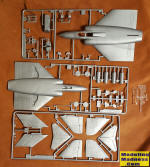
| KIT #: | 346 |
| PRICE: | $10.00 when new |
| DECALS: | Two options |
| REVIEWER: | Scott Van Aken |
| NOTES: | S |

| HISTORY |
The Gloster Javelin is a twin-engined T-tailed delta-wing subsonic night and all-weather interceptor aircraft that served with Britain's Royal Air Force from the mid-1950s until the late 1960s. The last aircraft design to bear the Gloster name, it was introduced in 1956 after a lengthy development period and received several upgrades during its lifetime to its engines, radar and weapons, which included the De Havilland Firestreak air-to-air missile.
The Javelin was succeeded in the interceptor role by the English Electric Lightning, a supersonic aircraft capable of flying at more than double the Javelin's top speed, which was introduced into the RAF only a few years later. The Javelin served for much of its life alongside the Lightning; the last Javelins were withdrawn from operational service in 1968 following the introduction of successively more capable versions of the Lightning.
The T.3 variant was a dual-control trainer version with no radar, bulged canopy for improved instructor visibility. All-moving tailplane, lengthened fuselage to compensate for altered centre of gravity, adding additional internal fuel. Retained four cannon; 22 production aircraft and one prototype. Many Javelin squadrons had one trainer.
| THE KIT |
 This
kit was apparently released in 1981 and that is when I bought this one. When I
peeled off the wrap today, I found that the kit was in great shape; even the
decals. The tube of glue was no longer present so apparently Heller stopped
including that about this time. All of the panel lines are raised, but well
done. The cockpit tub consists of two seats, two control panels, and two control
sticks.
This
kit was apparently released in 1981 and that is when I bought this one. When I
peeled off the wrap today, I found that the kit was in great shape; even the
decals. The tube of glue was no longer present so apparently Heller stopped
including that about this time. All of the panel lines are raised, but well
done. The cockpit tub consists of two seats, two control panels, and two control
sticks.
Heller than has you doing subassemblies such as the wheels,
landing gear, and the fin/stabilizer. Next the engine intake trunking is added
along with the exhaust section. The cockpit is attached to the upper fuselage
halve and an undetermined amount of weight is added to the nose section. Then
the upper/lower fuselage halves are attached. Note that the fuselage halves also
have the inboard sections of the wing. . The outboard sections are assembled and
attached along with the canopy, a few scoops and that is it. Pretty basic stuff,
I'd say. 
Instructions are several construction steps along with paints in Heller references, though a second sheet provides a guide as to what's what. There are two markings options. One is the box art plane from 60 Squadron based at Tengah in 1963. The other is a 72 Squadron plane based at Leconfield in 1960. Both aircraft are green/grey uppers with silver undersides. Decals are still in pretty good shape and though they will be a bit thick and matte, should work just fine as there are not compound curves to deal with.
| CONCLUSIONS |
I have always found it odd that Heller would do the trainer version as so few of this variant were actually built. Frog did the FAW.9R and that was a beast to build. Since then, only Airfix has done a Javelin kit and that is in 1/48. There are aftermarket decals if the ones in your kit are no longer viable.
November 2021
Copyright ModelingMadness.com. All rights reserved. No
reproduction in part or in whole without express permission.
If you would like your product reviewed fairly and
fairly quickly, please
contact
the editor or see other details in the
Note to
Contributors.